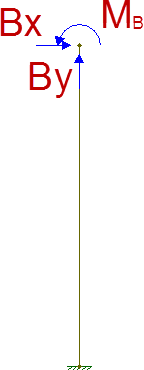How accurate are you trying to be?
Assuming the roller is ideal, it won't allow a torque, so resolve the impact force to x/y component forces at the center of the roller.
Assuming the base of the black roller pedestal is fixed (if the legs are going to flex, then it's not!), then the x/y forces at the top of the black pedestal will resolve to an x/y force and a moment at the base of the pedestal.
If the steel plate doesn't flex (if it's real, it will!), then it will transmit the forces and moment to the tops of the rods. You can then look up the formulas for deflection for the loads and sum the results.
But again, if the legs flex, the black roller pedestal will move. You are calling the force an "impact", which implies that it is a short-term, dynamic load.
An impact has an impulse profile, which shows force plotted over time. The area under the curve (integral) gives the impulse, which is typically constant for a given impact regardless of the "springiness" of the collision. A springy surface increases the impulse duration, reducing the peak force. This is why hitting an airbag is better than hitting a wall - lower peak force, even though both will bring your face to a stop.
All of this is to say that dynamic situations are extremely difficult to evaluate. These are typically done with numerical simulations, because dynamic deflection reduces the force transmitted at that particular instance.
Numerical simulations are used because you wind up with iterations around "loops" like the following:
- Assume nothing deflects, find max loading.
- Use that loading to deform the structural members.
- With the members deformed, the applied force is lower (because force times distance, energy, "drains" kinetic energy from the impact source)
- Run the process again with the lower applied force.
- Get new deflections, those get a new impact force, repeat, repeat, repeat.
Eventually this should stabilize at a particular deflection, but now that the structure has been deflected in some period of time there is an acceleration in the structure, which adds a force at each member that deflected.
If your question were about deflection under static load then I would say it's probably a suitable final exam question for a deformable bodies course (5th semester mechanical/civil engineering course). As it stands, this is more along the lines of a finite element analysis class, which would probably be a 4th year undergrad/graduate course.
Which is to say, if you are looking for accurate results, you're not going to find them here. You need to know more information about the source of the impact, the shape, size, material (including grade) of all of the structural members, a finite element analysis software package, and probably at least one class on how to use the software.


